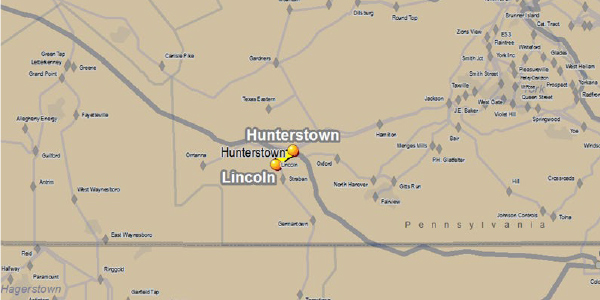By Michael Yoder
PJM is standing behind its original solution for congestion issues in the Met-Ed service territory in Pennsylvania, saying a $7 million rebuild of the 115-kV Hunterstown-Lincoln line was superior to a competing project from Ameren.
In a Feb. 11 letter, Jeffrey Hackman, senior director of transmission operations, technical services and business development for Ameren Transmission Company of Illinois (ATXI), asked the PJM Board of Managers to reconsider its decision to include the rebuild (Proposal HL_622) in the Regional Transmission Expansion Plan (RTEP) and to order RTO staff to “objectively and transparently re-evaluate” HL_622 and Ameren’s competing proposal (HL_469).
“ATXI does not make this request lightly but believes it is necessary to ensure that the process is just and reasonable and that customers receive the benefit of the process, which is supposed to result in the more efficient and/or cost-effective project being selected,” Hackman said.
On Wednesday, PJM CEO Manu Asthana told Hackman in a letter that the RTO continues to support the rebuild.
“We have reviewed the record once again and determined that the selection was fully supported by our own staff’s detailed analysis (which included meetings with your staff), the results of an independent consultant’s review, and a review of the cost estimates of the Ameren proposal as compared to other competing proposals,” Asthana wrote. “The results of our analyses were presented at the November 2019 Transmission Expansion Advisory Committee meeting. For these reasons and after this recent additional review of all of the underlying facts, PJM stands by the original selection decision.”
Asthana’s response may not be the end of the dispute. Hackman — who alleged PJM’s actions violated FERC Orders 890 and 1000, and the PJM Operating Agreement and manuals — copied FERC commissioners and top staff on his letter. Asthana did the same in his response.
The line upgrade selected is proposed for Adams County, Pa., territory of FirstEnergy’s Met-Ed, and was proposed by FirstEnergy’s Mid-Atlantic Interstate Transmission (MAIT) subsidiary. MAIT signed a designated entity agreement to perform the rebuild last month (Project b3145).
It was selected from 19 greenfield and three upgrade proposals submitted by seven entities in response to a competitive window that closed in March 2019. The proposals’ estimated costs ranged from $4.65 million to $290.95 million
Ameren’s proposal called for installing a SmartValve — which manufacturer SmartWires describes as a “single-phase, modular, static synchronous series compensator (SSSC), [which] injects a leading or lagging voltage in quadrature with the line current, providing the functionality of a series capacitor or series reactor respectively” — on the Hunterstown-Lincoln line. PJM estimated its cost at $7.15 million.
The PJM cost analysis for HL_622 came in at $7.21 million.
Discretion and Transparency
In his letter, Hackman said Ameren staff expressed concerns to PJM regarding the process the RTO applied to evaluate proposals on two separate occasions: the 2014 30-day reliability window and the 2016/17 long-term market efficiency window.
Hackman said their concerns included a lack of specificity in the OA that “mystifies the basis of decisions” and a lack of transparency and consistency in the decisions on the merits of proposals.
In his response, Asthana said FERC Order 1000 creates “new opportunities, but also new complexities” in regard to new transmission technologies.
In the November 2019 presentation to the TEAC, PJM staff raised concerns with Ameren’s proposal, citing “limited experience with [the] SmartValve device.”
PJM also said Ameren’s proposal had higher permitting risk than the rebuild because it required “new property for [a] substation due to location near historically sensitive area.”
Staff concluded the rebuild would provide additional system capability, while the Ameren proposal could increase flexibility. But PJM said it would not be able to fully exploit the dynamic capabilities of the SmartValve without making changes to the day-ahead and real-time SCADA systems.
It said the rebuild had a benefit/cost ratio of 76.41 versus 72.61 for the SmartValve.
Hackman said Ameren understands PJM has “considerable discretion” under its OA. “However, transparency is necessary when there is this level of discretion, and PJM staff appear to have forgotten that,” Hackman wrote.
“PJM staff did not provide necessary details in the November TEAC to stakeholders explaining why the detailed feasibility review that was performed on Proposal HL_469 resulted in a 53.7% increase to the estimated cost of Proposal HL_469, causing the benefit-to-cost (B/C) ratio for the project to fall below the B/C ratio for Proposal HL_622,” Hackman continued. “PJM failed to provide that information in a timely manner that allowed for review and discussion in the TEAC and before PJM staff presented their recommendation for approval to the PJM Board of Managers.”
Asthana’s letter did not address Ameren’s B/C claim.
Will the dispute end up before FERC?
Asthana offered an olive branch. “We are always open to stakeholder input on potential process improvements and are committed to transparency and communication with stakeholders as part of the evaluation process,” he said. “We appreciate Ameren’s willingness to focus, at this point, on discussing with PJM and other stakeholders potential enhancements to our market efficiency competitive process and appreciate your proposals on these subjects.”



